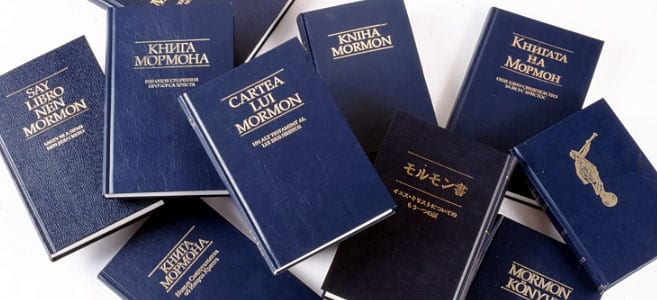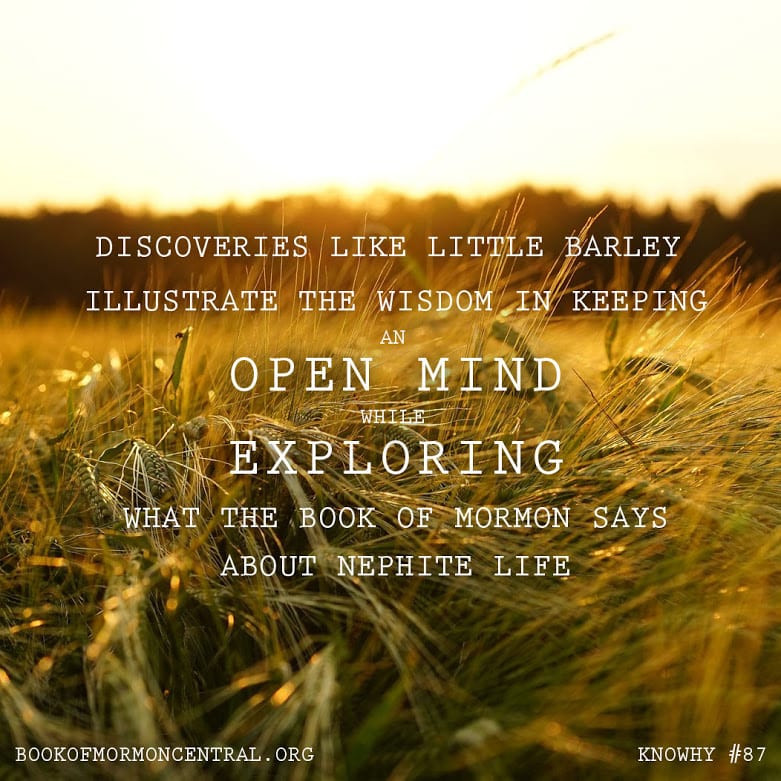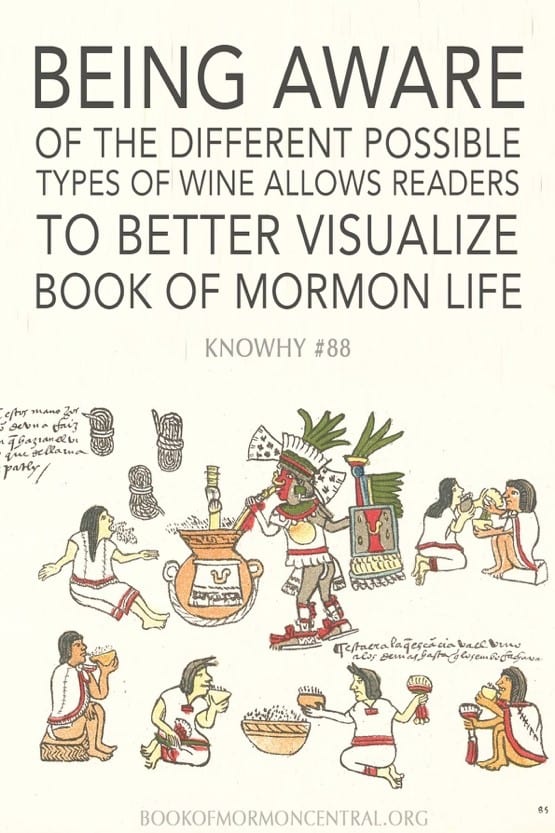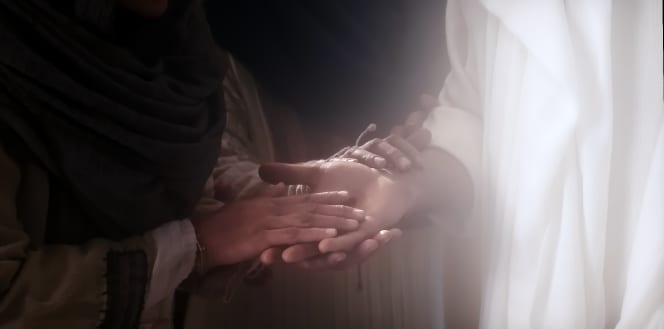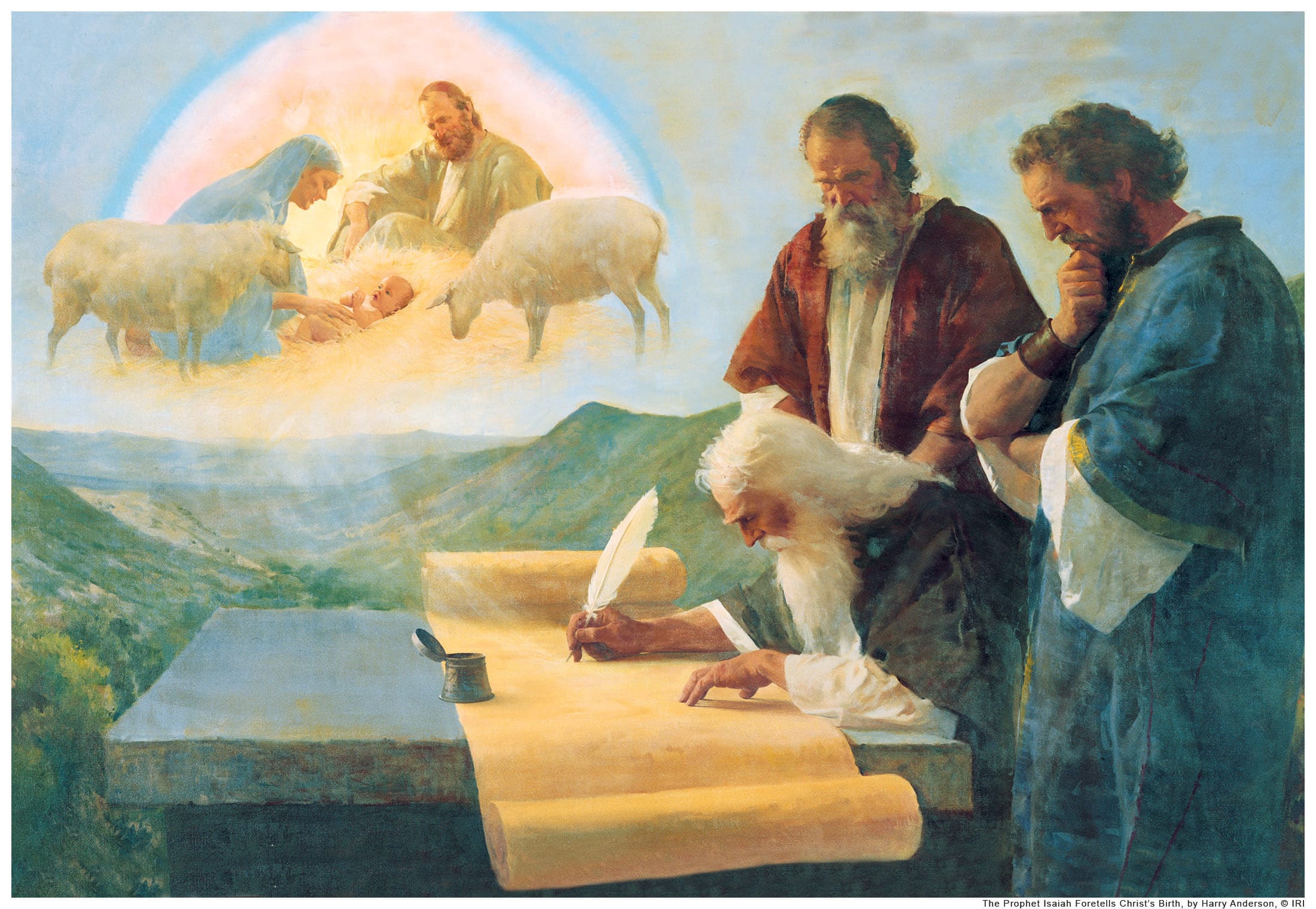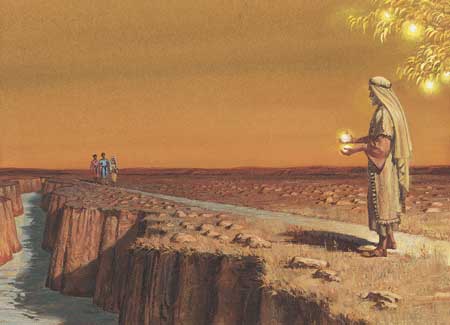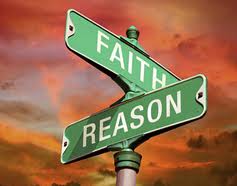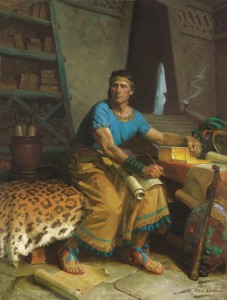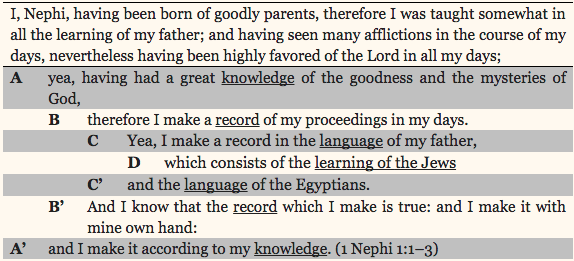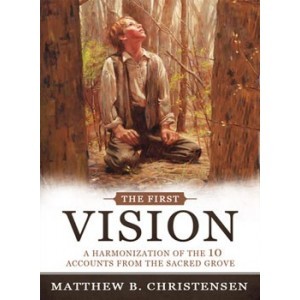Abstract: From the very beginning, Joseph’s story about the origins of the Book of Mormon seemed wild and unbelievable. Today, however, Joseph’s account enjoys a high degree of corroboration from (1) eyewitness accounts confirming Joseph’s possession of actual metal plates and other artifacts, with some even corroborating the involvement of an angel in providing access to the record; (2) eyewitness reports on the process of producing the text; and (3) evidence from the original manuscript. This evidence is reviewed here, and the implications it has for the Book of Mormon’s origin are considered.
The stories Joseph Smith told about the origins of the Book of Mormon are quite fantastic. He said that in 1823 one of the ancient authors, Moroni, came to him as an angel and told him where the record was hidden. After four years under Moroni’s annual tutelage, Joseph was permitted to recover the record engraved on a set of gold plates from its resting place in a stone box in a hill. Joseph was empowered by God to translate the record, through the medium of “interpreters,” or seer stones. Thus empowered, he dictated to scribes such as his wife Emma, Martin Harris, Oliver Cowdery, and others. This is the origin of the Book of Mormon, per Joseph Smith.1
Naturally, this narrative was greeted with skepticism by those outside Joseph’s inner circle and continues to be doubted by many today. In January 1830, newspaper editor Abner Cole wrote a biting satire about Joseph Smith and his stories about angels, gold plates, and divine translation. Cole lumped these tall tales in with “Idle and Slothful strange stories of hidden treasures and of the spirit who had the custody thereof.”2 The story continues to be lumped in with tales of Captain Kidd and other money-diggers lore today3 and forms part of the rationale for why even some professed Latter-day Saints would have us abandon any kind of defense of the book’s origins, opting instead for some sort of vague “inspired-fiction” view of the Book of Mormon.4
Though this story may seem wild and unbelievable to the modern skeptic, its elements actually fit ancient patterns for the discovery of lost books.5 The account also enjoys a high degree of corroboration from (1) eyewitness accounts confirming Joseph’s possession of actual metal plates and other artifacts, with some even corroborating the involvement of an angel in providing access to the record; (2) eyewitness reports on the process of producing the text; and (3) evidence from the original manuscript. These three items are addressed in this paper.
Artifacts and Angels
Anthony Sweat, assistant professor of Church History at BYU, talks about how remarkably physical the Book of Mormon’s origins are.
Joseph said the Book of Mormon came forth from a nearby hill, by removing dirt, using a lever to lift a large stone, and removing actual engraved plates and sacred interpreters for the translation of its inscriptions. The Book of Mormon text didn’t just pass through Joseph’s trance-induced revelatory mind; its palpable relics passed through a clothing frock, hollowed log, cooper’s shop, linen napkin, wooden chest, fireplace hearth, and barrel of beans.6
The physicality of these artifacts was experienced by a wide variety of men and women in a wide variety of ways. As Richard Lloyd Anderson explained decades ago,
The plates figured in the regular life of Joseph Smith for over a year and a half. … He worried about obtaining them, [and] guarded them carefully during this period. … This meant that those nearest him shared in his strategies for preserving and using them. So a larger circle than the official witnesses had some contact with the ancient record in their daily affairs.7
To start, there are the official eleven witnesses. Just prior to publishing the Book of Mormon, Joseph Smith showed the plates to two separate groups of people. The first consisted of Oliver Cowdery, Martin Harris, and Cowdery’s brother-in-law David Whitmer. These three all testified that after praying with Joseph Smith, an angel showed them the plates on which the Book of Mormon was written.8 Another set of witnesses, consisting of David’s brothers Christian Whitmer, Jacob Whitmer, Peter Whitmer Jr., John Whitmer, their brother-in-law Hiram Page, and Joseph’s father and brothers, Joseph Smith Sr., Hyrum Smith, and Samuel Smith were shown the record under ordinary circumstances and allowed to handle the plates.9
Both sets of witnesses had group testimonies drafted and published within the covers of the Book of Mormon. Many of the individuals also made frequent statements throughout their lives as they were questioned about the experience by believers and skeptics alike. The earliest of these on record comes from Oliver Cowdery a few months after the experience. In response to a newspaper editor inquiring about the Book of Mormon, Oliver wrote, “It was a clear, open beautiful day, far from any inhabitants, in a remote field, at the time we saw the record, of which it has been spoken, brought and laid before us, by an angel, arrayed in glorious light, [who] ascend [descended I suppose] out of the midst of heaven.”10
Oliver later left the Church, yet there is no indication that he ever denied his testimony of the Book of Mormon.11 After returning to the Church in 1848 at a Conference held in Council Bluffs, Iowa, Oliver delivered a stirring address. Included in that address was the declaration, “I beheld with my eyes, and handled with my hands, the gold plates from which [the Book of Mormon] was translated. I also saw with my eyes and handled with my hands the Holy Interpreters. That book is true.”12
In a letter written in 1870, Martin Harris testified: “I do say that the angel did show me the plates containing the Book of Mormon.”13 In 1887, after all the other witnesses had passed away, David Whitmer, though no longer a member of the Church, continued to fulfill the charge they had received in 1830. “I will say once more to all mankind,” he wrote, “that I have never at any time denied that testimony or any part thereof. I also testify to the world, that neither Oliver Cowdery or Martin Harris ever at any time denied their testimony.”14
Similar individual statements can be found among the eight witnesses. The Prophet’s brother Hyrum Smith said, “[H]e had but two hands and two eyes” and that “he had seen the plates with his eyes and handled them with his hands.”15 In 1839, after enduring the bleakness of Liberty Jail, Hyrum Smith wrote, “I thank God that I felt a determination to die, rather than deny the things which my eyes had seen, which my hands had handled.”16 In 1847, after leaving the Church, Hiram Page said, speaking of the Book of Mormon, it would be “doing injustice to myself and to the work of God of the last days, to say … my mind was so treacherous that I had forgotten what I saw.”17
John Whitmer, like his brother David, is one of the witnesses who left the Church and never returned. Once, after leaving the Church, he stood before some of his anti-Mormon friends and was questioned about his witness of the Book of Mormon by Theodore Turley. With all the peer pressure in the world telling him to deny his testimony, John declared, “I now say I handled those plates. There was fine engravings on both sides. I handled them.”18 Decades later, after most of the other witnesses had passed away, John responded by letter to someone asking about his testimony in the Book of Mormon. “I have never heard,” he wrote, “that any one of the three or eight witnesses ever denied the testimony that they have borne to the Book as published in the first edition of the Book of Mormon.”19
The two sets of witnesses are complemented by the additional experiences and informal interactions with the plates that others had. These include Alvah Beaman, Josiah Stowell, and Joseph Knight Sr. along with other members of Joseph Smith’s family, such as his wife Emma, his mother Lucy, and his brother and sister, William and Katharine.20 Although most of these people never actually saw the plates, they can attest that Joseph Smith really did have a tangible object. They felt, lifted, and moved this object around (while covered). They could feel the weight, contours, and shape of the object well enough to discern that it was not blocks of wood or stones.21 They could lift the individual pages (or plates), hear them make a metallic rustling sound as they moved,22 and feel that they were bound by three rings.23
Their experiences are so straightforward they cannot be easily dismissed. Both Emma and Katharine moved the covered plates around the house as they did daily chores,24 Josiah Stowell caught a glimpse of their corner as the covering slipped off when Joseph handed them to him,25 Alvah Beaman heard the metallic clinking of the plates as he helped move them around in the wooden chest,26 and Martin Harris let them sit, covered, on his knee for some time as he talked with Joseph in the woods while they were preparing to hide the plates from a mob.27 Others reported finding the stone box in the hill after it had been emptied of its contents.28 These are mundane, ordinary, even day-to-day experiences. Experiences like these bring a certain tangibility and physicality to the plates that makes them hard to remove from historical reality.
There is also the experience of Mary Whitmer, who saw both the plates and the angel. Her experience is interesting because, even though it includes the divine messenger, even he is portrayed in rather ordinary terms. He shows up as a man while she is out milking cows, he shows her the record, and then he is gone.29
This is only a small sampling of the many accounts that exist from the various witnesses.30 While it is easy to scrutinize and dismiss these testimonies now, for those living in the vicinity of Palmyra at the time, it was much harder to ignore. As a pair of historians who work for the The Joseph Smith Papers Project explain, “Joseph’s initial problems with enemies in 1827 were precisely because they were certain that he had in fact obtained some golden treasure from the hill.”31
All of this makes notions of co-conspirators or easily duped followers very difficult to square with the historical record. There are too many people with too many stories about interactions with the plates and other artifacts. Several left the Church while continuing to bear their witness of the plates. As Richard Lloyd Anderson noted, several were strong-willed individuals who “tended to compete rather than cooperate with [Joseph Smith’s] leadership.”32 Given such circumstances, it would be impossible to keep a conspiracy under wraps, and their tendency to compete with Joseph’s leadership indicates they are not likely to be easily duped.
The different types of experiences of the various witnesses provide what Terryl Givens called “an evidentiary spectrum, satisfying a range of criteria for belief.” He elaborates:
The reality of the plates was now confirmed by both proclamation from heaven and by empirical observation, through a supernatural vision and by simple, tactical experience, by the testimony of passive witnesses to a divine demonstration and by the testimony of a group of men actively engaging in their own unhampered examination of the evidence.33
While Givens was only speaking of the official witnesses, the experiences of others who interacted with these objects further expands the evidentiary spectrum. For these participants, the plates and other objects were an omnipresent reality, sometimes out of sight but never really out of mind. They helped protect them from mobs trying to take the plates, either to get rich, expose the fraud, or both. They moved them around while doing daily chores. Homes were ransacked, marriages were severed, and family ties strained to the limit — all over whatever Joseph had hidden under that linen cloth or secured in his wooden chest. “From Nephi to Joseph and Emma,” Brant A. Gardner notes, “the Book of Mormon was intensely physical, intensely tangible.”34
Steven C. Harper of the Church Historical Department feels that the witnesses’ testimonies “are some of the most compelling evidence in favor of its miraculous revelation and translation.” Indeed, Harper notes that, “[f]or believers,” such testimony “approaches proof of Joseph Smith’s miraculous claims.”35 But what of doubters and skeptics?
“The witnesses’ statements were an effective demonstration of authenticity for a skeptical age,” according to Richard Lyman Bushman, a highly respected early American historian and former Howard W. Hunter chair of Mormon Studies at Claremont Graduate School. “Secular historians have never come to grips with the fact that none of the eleven who saw the plates (in addition to Joseph Smith) ever recanted.”36
All told, these accounts corroborate Joseph Smith’s claim to having a set of metal plates and other objects within his possession. Some support his assertions of having retrieved them from a stone box in the Hill Cumorah. Additionally, several eyewitnesses were also introduced to the angel who was involved in revealing the plates. This creates a large body of historical evidence consistent with Joseph Smith’s claims.
Translation Process
There is an abundance of documentation on the process by which the English text was produced.37 Using that documentation, researchers have determined that the bulk of the translation occurred between April and June 1829, in a period only a little longer than two months — a rate of about eight pages per day.38 This was accomplished amidst a variety of other activities that had to be done, such as the dictation of twelve additional revelations (now in the Doctrine and Covenants), application for copyright, and hostile interactions with neighbors, which eventually mandated a relocation of the translation from Harmony, Pennsylvania, to Fayette, New York, a distance of a hundred miles.39 “Besides translating,” Bushman writes, “Joseph received revelations for his brother Hyrum and the helpful Joseph Knight, and was instructed by the Lord to translate the small plates of Nephi rather than go back again to Lehi’s longer record. But through all of the ambient events, the main project ground on, the words coming relentlessly from Joseph’s mouth and going onto paper under Cowdery’s pen.”40
Witnesses to the process have insisted that Joseph Smith had no other book or manuscript with him from which to draw material.41 Using a hat to shield out the light as he focused on his seer stone, Joseph could not have read from a manuscript because, as he once told Martin Harris (who had switched out the seer stone with a different rock), it was “dark as Egypt” in the hat.42 Despite that, however, Joseph seemed to be reading from something because he would have his scribe recite back what was written to verify its accuracy.43 After countless interruptions, Joseph always started back right where he left off, without ever checking with his scribe to see what was last dictated.44 Sometimes Joseph had trouble pronouncing the names of the various characters in the narrative, including that of the name Sariah, Nephi’s mother.45 On at least one occasion, the content of the text seemed to surprise Joseph. For example, on one occasion when Emma was acting as his scribe, she remembered,
[O]ne time while he was translating he stopped suddenly, pale as a sheet, and said, “Emma, did Jerusalem have walls around it?” When I answered “Yes,” he replied “Oh! I was afraid I had been deceived.” He had such limited knowledge of history at that time that he did not even know that Jerusalem was surrounded by walls.46
In the words of Martin Harris, “Joseph knew not the contents of the Book of Mormon until it was translated.”47
Evidence from the remaining portions of the original manuscript corroborates much of the witnesses’ testimony. Royal Skousen, a linguist who has led the Book of Mormon Critical Text Project for over a quarter century,48 has observed that the kind of errors found in the original manuscript reflect the mishearing, rather than the misreading, of the words, indicating that the original text was dictated to scribes. His analysis leads him to conclude that Joseph could only read twenty to thirty words at a time. Names are often misspelled and then corrected, supporting the witnesses’ testimony that Joseph would sometimes spell out the proper names. There are immediate changes to errors, consistent with the scribes reading back the text to Joseph to have it verified. Consistent with Joseph’s being unfamiliar with the text, the manuscript shows that Joseph did not always know when a break in the text was the beginning of a new chapter or a whole new book, specifically evidenced in the manuscript at the division between 1 and 2 Nephi.49
To summarize, both the eyewitness and manuscript evidence suggest that Joseph was reading a text, but not from any manuscript or book. He only had access to limited portions of the text at a time, and did not have personal control over the text. There is no long, drawn out composition process — over five hundred pages were rattled off into a complex, coherent narrative in just over two months’ time, a miraculous feat in its own right. After breaks, he did not go back to do extensive revisions, nor did he need to review what had already been written, as an author normally would. He could not pronounce some of the names, and the information in the text was often as new to him as it was to his scribes and those observing the process. Overall, this evidence suggests that the text was not his own.
It is impossible to prove that something is miraculous or divine, but all of the above evidence is consistent with the story told by Joseph himself — that he dictated a text given to him by revelation, through the medium of an “interpreter,” or a seer stone.50 Taken together, Joseph Smith’s basic account, from the angel delivering the record on metal plates to the translation provided by “the gift and power of God,” is supported, to the extent possible, by the best primary sources on the coming forth of the text.
The Implications for Origins
In his study on authorship attribution, Harold Love explained that an important class of evidence includes “[c]ontemporary attributions contained in … titles, and from documents purporting to impart information about the circumstances of composition — especially diaries, correspondence, publishers’ records, and records of legal proceedings.”51 While the Book of Mormon title page listed Joseph Smith as the “author and proprietor” of the text in 1830, this was clearly done for copyright reasons.52 Therefore, the historical evidence, summarized here, coming from the people most familiar with “the circumstances of composition,” must be dealt with in any attempt to explain the origins and authorship of the Book of Mormon.
Such evidence makes it difficult to dismiss these narratives as “idle and slothful strange stories,” or otherwise explain them. Despite continued efforts by some critics to posit some other author, such as Sidney Rigdon or Solomon Spaulding,53 the evidence really allows only for Joseph Smith as a potential author in 1830. Too many people saw and described the process of Joseph, head in hat, dictating the text for it to be any other way.54 Yet Joseph as author also quickly runs into problems.
Joseph was unfamiliar with the content (Jerusalem’s walls) and structural divisions (mislabeled division between 1 and 2 Nephi), and could not pronounce at least some of the names (like Sariah). Why would this be if the text was Joseph’s own creation? Add to that the questions of where the plates and other artifacts in his possession came from, which are also corroborated by eyewitness testimony. Despite these problems, Joseph Smith and several of the other nineteenth century persons have been proposed as the author(s) of the text. Such proposals fail the test of historical evidence. Overall, the external evidence is consistent with Joseph Smith’s own explanation of events — including the angel and the plates — more than any other.
A great deal of creativity has been expended trying to account for all this in some other way. Some have argued,55 for example, that Joseph Smith manufactured a fake set of plates, even appealing to known forgeries such as the Voree and Kinderhook plates, as analogs. Such arguments suffer from a number of difficulties:
- This is an ad hoc explanation, necessitated by the witnesses’ testimonies but not actually supported by them or any other historical evidence.
- The Voree and Kinderhook plates are small and crude and were obviously made of easily available materials. The Book of Mormon plates, on the other hand, are a different story entirely. Reconstructions of them based on witness descriptions prove extremely difficult.56 These plates were a well-crafted artifact far beyond the skills of Joseph Smith.57
- Lastly, witnesses attested to several other artifacts, such as the Liahona, Sword of Laban, the breastplate, and Interpreters.58 If the plates alone were beyond Joseph’s skill set to manufacture, then these added props certainly complicate the matter. It seems difficult to maintain that Joseph Smith created these artifacts himself (or with others). There is no evidence to support such an argument.
Others, then, turn to conspiracy theories, as already discussed. All the eyewitnesses to both the plates and the translation are from Joseph Smith’s “inner circle,” and thus they colluded with him on a major hoax. This theory breaks down quickly, however. Too many of these persons were later estranged from Joseph Smith and the Church, and yet not one backed away from his testimony nor exposed a conspiracy. Added to that is the fact that most of the eyewitness accounts are made after their estrangement from Joseph, independently and spontaneously upon questioning and cross-examination (sometimes from skeptical interviewers), during a time when these witnesses were scattered and isolated from each other, when no collusion was possible.59
Richard Lloyd Anderson is both a historian and an attorney. His legal background is evident in the way he examines historical sources. While some regard such approaches as problematic, it has its merits as well. When trying to discern potential conspirators, for instance, Anderson’s interrogative approach is quite valuable. With the acumen of a seasoned trial attorney accustomed to discerning when witnesses are covering something up, he examined both the public and private statements left behind by Joseph Smith and Oliver Cowdery from the period of translation. He found no deception but instead sincerity.
Profound faith and reverence characterize Joseph and Oliver in the early years of the Church. … The early Joseph and Oliver are men with missions, servants of Christ devoted to his work. This is supremely relevant in judging their Book of Mormon translation. They are the kind of men that God would use in such a great work. Their lives and thoughts are in harmony with what they claimed to do. … Their intense prayerfulness is consistent with communion with God. Not only is their translation story credible by numerous practical tests — the translators themselves emerge as spiritually credible.
… Did Oliver and Joseph translate by revelation and receive testimony and authority from angels? One must judge their credibility and discern the product of their work. Their activities are verified and their lifetime testimonies unwavering. The translators’ minds harmonize with their prophetic call. Moreover, their claims are phrased with the confident simplicity of men who expect to be believed. What they said is important, but so also is how they said it; lack of overstatement in their first testimonies underlines depth of conviction.60
Such sincerity is problematic for theories of fraud or conspiracy. Richard Lyman Bushman, widely regarded as the leading expert on the life of Joseph Smith, reached a similar conclusion after reviewing the primary sources for the recovery and translation period. Speaking of Joseph Smith’s unpublished 1832 history, for example, Bushman observes:
The passage has an endearing candor to it. Joseph admits his teenage transgressions and his hope for forgiveness. He comes across as a learner trying to understand what he is to do. He is baffled when he cannot get the plates and wonders for an instant if he had just dreamed the vision. He is terrified that he has done something wrong. The angel at times frightens him. When he is rebuked, Joseph recognizes that he had been thinking of gold and riches, not of the glory of God. He is relieved to record the assurance that by repentance he could be forgiven and get the plates eventually. … The passage captivates a reader, making it hard to doubt Joseph’s sincerity. Inserting too much of language like this into a secular account would diffuse the search for Book of Mormon sources and turn attention to Joseph’s desire to comply with the will of heaven.
This is why, Bushman explains, “believing historians are more inclined to be true to the basic sources than unbelieving ones.”61
Counter-explanations ultimately fall flat of accounting for all the historical evidence, and they needlessly multiply hypotheses. They are particularly inadequate to account for the sincerity and honesty that both Anderson and Bushman discern in the most reliable primary sources. The most parsimonious explanation remains that given by Joseph Smith himself: an angel showed him where to find a record engraved on metal plates. This record was translated by means of revelation, through the medium of seer stones (called “interpreters” by the record itself), and published as the Book of Mormon.
References
1. The most accessible primary source for all of this is Joseph Smith’s own history written in 1838–1839, included in the LDS standard works as Joseph Smith — History. For additional treatments of the topic that cite the relevant primary sources, see Richard E. Turley Jr. and William W. Slaughter, How We Got the Book of Mormon (Salt Lake City: Deseret Book, 2011), 1–23; Matthew B. Brown, Plates of Gold: The Book of Mormon Comes Forth (American Fork, UT: Covenant Communications, 2003), 3–97; Brant A. Gardner, The Gift and Power: Translating the Book of Mormon (Salt Lake City: Greg Kofford Books, 2011), 3–134; Paul C. Gutjahr, The Book of Mormon: A Biography (Princeton: Princeton University Press, 2012), 11–37; Michael Hubbard MacKay and Gerrit J. Dirkmaat, From Darkness unto Light: Joseph Smith’s Translation and Publication of the Book of Mormon (Salt Lake City: BYU Religious Studies Center and Deseret Book, 2015), 3–134.
2. Obadiah Dogberry [Abner Cole], “The Book of Pukei,” Palmyra Reflector (June 12, 1830), 36.
3. See Ronald V. Huggins, “From Captain Kidd’s Treasure Ghost to the Angel Moroni: ChangingDramatis Personae in Mormonism,” Dialogue: A Journal of Mormon Thought 36/4 (2003): 17–42. For evaluation of such arguments from a faithful LDS perspective, see Larry E. Morris, “‘I Should Have an Eye Single to the Glory of God’: Joseph Smith’s Account of the Angel and the Plates,” FARMS Review 17/1 (2005): 11–81; Mark Ashurst-McGee, “Moroni as Angel and as Treasure Guardian,” FARMS Review 18/1 (2006): 34–100.
4. See for example, Anthony A. Hutchinson, “The Word of God Is Enough: The Book of Mormon as Nineteenth-Century Scripture,” in New Approaches to the Book of Mormon: Explorations in Critical Methodology, ed. Brent Lee Metcalfe (Salt Lake City: Signature Books, 1993), 1–19; Robert M. Price, “Joseph Smith: Inspired Author of the Book of Mormon,” inAmerican Apocrypha: Essays on the Book of Mormon, ed. Dan Vogel and Brent Lee Metcalfe (Salt Lake City: Signature Books, 2002), 321–366.
5. See John A. Tvedtnes, The Book of Mormon and Other Hidden Books: “Out of Darkness Unto Light” (Provo, UT: FARMS, 2000).
6. Anthony Sweat, “Hefted and Handled: Tangible Interactions with Book of Mormon Objects,” in The Coming Forth of the Book of Mormon: A Marvelous Work and a Wonder, ed. Dennis Largey, Andrew H. Hedges, John Hilton III, and Kerry Hull (Provo/Salt Lake: BYU Religious Studies Center and Deseret Book, 2015), 44.
7. Richard Lloyd Anderson, Investigating the Book of Mormon Witnesses (Salt Lake City: Deseret Book, 1981), 21, brackets mine, capitalization altered.
8. See “The Testimony of Three Witnesses,” in the front of contemporary editions of the Book of Mormon.
9. See “The Testimony of Eight Witnesses,” in the front of contemporary editions of the Book of Mormon.
10. Oliver H.P. Cowdery to Cornelius C. Blatchly, November 9, 1829, printed in Cornelius C. Blatchly, “The New Bible,” Gospel Luminary 2/49 (December 10, 1829): 194. Brackets represent the commentary of Blatchly. An image of this source is available online athttp://www.juvenileinstructor.org/wp-content/uploads/2012/08/1829-12-10-v2n49-copy.jpg (accessed July 26, 2014).
11. See Anderson, Investigating the Book of Mormon Witnesses, 37–47.
12. Reuben Miller Journal, cited in Richard Lloyd Anderson, “Reuben Miller, Recorder of Oliver Cowdery’s Reaffirmations,” in Oliver Cowdery: Scribe, Elder, Witness, ed. John W. Welch and Larry E. Morris (Provo, UT: Neal A. Maxwell Institute for Religious Scholarship, 2006), 402.
13. Martin Harris to Hannah Emerson, November 23, 1870, printed in “Correspondence,” inTrue Latter Day Saints’ Herold 22/20 (Plano, IL; October 15, 1875), 630.
14. David Whitmer, An Address to All Believers in Christ (Richmond, MO: David Whitmer, 1887), 8.
15. Sally Bradford Parker to John Kempton, August 26, 1838; transcribed in Janiece L. Johnson, “‘The Scriptures Is a Fulfilling’: Sally Parker’s Weave,” BYU Studies 44/2 (2005): 115, spelling, punctuation, and capitalization standardized. Original reads: “he said he had but too hands and too eyes he said he had seene the plates with his eyes and handeled them with his hands”.
16. Hyrum Smith to the Saints, December 1829, printed at “Communications,” Times and Seasons 1/2 (December 1839): 23.
17. Hiram Page to William E. McLellin, May 30, 1847; cited by Steven C. Harper, “The Eleven Witnesses,” in The Coming Forth of the Book of Mormon, 122.
18. Memorandum of Theodore Turley, April 4, 1839; cited by Anderson, Investigating the Book of Mormon Witnesses, 131.
19. John Whitmer to Mark H. Forest [Forscutt], March 5, 1876; cited by Harper, “The Eleven Witnesses,” 123.
20. For summaries of the experiences of these individuals, see Anderson, Investigating the Book of Mormon Witnesses, 21–34; Brown, Plates of Gold, 48, 78 n. 83; MacKay and Dirkmaat, From Darkness unto Light, 13, 15–16. For Alvah Beaman, see William J. Hamblin, “An Apologist for the Critics: Brent Lee Metcalf’s Assumptions and Methodologies,” Review of Books on the Book of Mormon 6/1 (1994): 519.
21. William Smith, “Sermon in the Saints Chapel,” The Saints’ Herald 31 (1884): 643–644.
22. Emma Smith, Interview between February 4–10, 1879, The Saints’ Herald 26 (1879): 290; William Smith, “Sermon in the Saints Chapel,” 643–644; Joel Tiffany, “Mormonism — No. II,”Tiffany’s Monthly 5 (August 1859): 167; MacKay and Dirkmaat, From Darkness unto Light, 15; Michael R. Ash, Of Faith and Reason: 80 Evidences Supporting the Prophet Joseph Smith(Springville, UT: Cedar Fort, 2008), 14.
23. Interview of William Smith by E.C. Briggs and J. W. Peterson, Zion’s Ensign (January 13, 1894): 6; Lucy Mack Smith, reported in Henry Caswall, The City of the Mormons; or, Three Days at Nauvoo, in 1842, 2nd ed., revised and enlarged, (London: J. G. F. & J. Rivington, 1843), 26.
24. Emma Smith, The Saints’ Herald 26:290; MacKay and Dirkmaat, From Darkness unto Light, 15.
25. See “Mormonism,” New England Christian Herald 4/6 (Boston, MA; November 7, 1832); reprinted in Morning Star 8/29 (Limerick, ME; November 16, 1832); transcripts online athttp://www.sidneyrigdon.com/dbroadhu/NE/miscne01.htm#110732 andhttp://www.sidneyrigdon.com/dbroadhu/NE/miscMe01.htm#111632 respectively (accessed August 2, 2015).
26. Tiffany, “Mormonism — No. II,” 167.
27. “Testimonies of Oliver Cowdery and Martin Harris,” Millennial Star 21 (August 20, 1859): 545.
28. See MacKay and Dirkmaat, From Darkness unto Light, 9–10.
29. Three different accounts are all transcribed in Royal Skousen, “Another Account of Mary Whitmer’s Viewing of the Golden Plates,” Interpreter: A Journal of Mormon Scripture 10 (2014): 35–44.
30. Unfortunately, there is no complete collection of these accounts. Preston Nibley, comp., The Witnesses of the Book of Mormon (Salt Lake City: Deseret Book, 1968) does gather a handful, though the collection is incomplete and out of date.
31. MacKay and Dirkmaat, From Darkness unto Light, 10.
32. Richard Lloyd Anderson, “Cowdery, Oliver,” in To All the World: The Book of Mormon Articles from the Encyclopedia of Mormonism, comp. Daniel H. Ludlow, S. Kent Brown, and John W. Welch (Provo, UT: FARMS, 2000), 78, brackets mine.
33. Terryl L. Givens, By the Hand of Mormon: The American Scripture that Launched a New World Religion (New York: Oxford University Press, 2002), 40.
34. Brant A. Gardner, Traditions of the Fathers: The Book of Mormon as History (Salt Lake City: Greg Kofford Books, 2015), xv.
35. Harper, “The Eleven Witnesses,” 19. For a brief evaluation of the witnesses and their role, for believers, in God’s “proof system of the Book of Mormon,” see Book of Mormon Central, “Who Are the ‘Few’ Who Were Permitted to See the Plates? (2 Nephi 27:12–13), KnoWhy 54 (March 15, 2016), online at https://knowhy.bookofmormoncentral.org/content/who-are-the-few-who-were-permitted-to-see-the-plates (accessed April 19, 2016).
36. Richard Lyman Bushman, “The Recovery of the Book of Mormon,” in Book of Mormon Authorship Revisited, ed. Noel B. Reynolds (Provo, UT: FARMS, 1997), 33. For the most recent attempt to grapple with this issue by a non-Mormon, see Ann Taves, “History and the Claims of Revelation: Joseph Smith and the Materialization of the Golden Plates,” Numen: International Review for the History of Religions 61 (2014): 182–207.
37. My argument here is similar to that of Daniel C. Peterson, “A Response: What the Manuscripts and the Eyewitnesses Tell Us about the Translation of the Book of Mormon,” inUncovering the Original Text of the Book of Mormon: History and Findings of the Critical Text Project, ed. M. Gerald Bradford and Alison V.P. Coutts (Provo, UT: FARMS, 2002), 67–71. Also see Daniel C. Peterson, “Editor’s Introduction — Not So Easily Dismissed: Some Facts for Which Counterexplanations of the Book of Mormon Will Need to Account,” FARMS Review17/2 (2005): xi–xxiv, xxx–xxxii.
38. See John W. Welch and Tim Rathbone, “How Long Did it take to Translate the Book of Mormon?” in Reexploring the Book of Mormon, 1–8; For a much longer and thorough examination, see John W. Welch, “The Miraculous Translation of the Book of Mormon,” in Opening the Heavens: Accounts of Divine Manifestations, 1820–1844, ed. John W. Welch (Provo, UT: BYU Studies, 2005), 77–117. Immediately following the article, from pages 118–213 are transcriptions of the relevant statements regarding the translation process, from a total of 202 documents. The primary sources used in this section can all be found in this collection. The citation to pages in Opening the Heavens will be provided only for documents difficult to access directly.
39. I’ve somewhat paraphrased Russell M. Nelson, “A Testimony of the Book of Mormon,”Ensign (November 1999): 71 on additional events occurring during translation. All these activities are documented in Welch, “The Miraculous Translation,” 77–117.
40. Bushman, “The Recovery of the Book of Mormon,” 32.
41. See Joseph Smith III, “Last Testimony of Sister Emma,” The Saints’ Herald (1 October 1879): 289–290.
42. “The Three Witnesses to the Book of Mormon,” Millennial Star 48 (June 21, 1886): 389–390.
43. See Edward Stevenson, letter to the editor (reporting an interview with Martin Harris) November 30, 1881, Deseret Evening News (December 13, 1881), interview occurred in 1870; Eri B. Mullen, “Letter to the Editor,” (reporting an interview with David Whitmer) The Saints’ Herald 27 (March 1, 1880): 76; Interview of David Whitmer reported in Kansas City Journal(June 5, 1881).
44. See Smith III, “Last Testimony of Sister Emma,” 290.
45. See Edmund C. Briggs (reporting an interview with Emma Smith), “A Visit to Nauvoo in 1856,” Journal of History 9 (October 1916): 454; E.C. Briggs (reporting an interview with David Whitmer), “Letter to the Editor,” The Saints’ Herald 31 (June 21, 1884): 396–397; “The Book of Mormon,” (reporting an interview with David Whitmer) Chicago Tribune (December 17, 1885): 3.
46. See Briggs, “A Visit to Nauvoo in 1856,” 454; cf. Nels Madsen, “Visit to Mrs. Emma Smith Bidamon [in 1877],” 1931, Church Archives, transcribed in Openings the Heavens, 129–130;Chicago Tribune, 3; M.J. Hubble, interview of David Whitmer, November 13, 1886, Missouri State Historical Society, Columbia, MO, transcribed in Opening the Heavens, 155–156. For commentary on this event, see Book of Mormon Central, “Did Jerusalem Have Walls Around It? (1 Nephi 4:4),” KnoWhy 7 (January 8, 2016), online athttps://knowhy.bookofmormoncentral.org/content/did-jerusalem-have-walls-around-it(accessed April 19, 2016).
47. Orson Hyde (clerk), Council minutes from Kirtland, OH, February 12, 1834; in Fred C. Collier and William S. Harwell, eds., Kirtland Council Minute Book (Salt Lake City: Collier’s Publishing Company, 2002), 23.
48. For background on the Book of Mormon Critical Text Project, Royal Skousen, “The Original Text of the Book of Mormon,” Interpreter: A Journal of Mormon Scripture 7 (2013): 57–96.
49. See Royal Skousen, “Translating the Book of Mormon: Evidence from the Original Manuscript,” in Book of Mormon Authorship Revisited, 67–87.
50. The exact mechanics of how one actually sees and translates using a seer stone are unclear, but the best attempt at explaining this is made by Gardner, The Gift and Power, 250–315. Other writers have explicitly avoided trying to explain, instead choosing to focus on capturing the miracle of the Book of Mormon translation as Joseph Smith and his contemporaries experienced it. See, for example, MacKay and Dirkmaat, From Darkness unto Light, xiii–xvi.
51. Harold Love, Attributing Authorship: An Introduction (Cambridge, UK: Cambridge University Press, 2002), 51.
52. See Michael Hubbard MacKay, Gerrit Dirkmaat, Grant Underwood, Robert J. Woodford, and William G. Hartley, Documents, Volume 1: July 1828–June 1831, The Joseph Smith Papers (Salt Lake City: Church Historian’s Press, 2013), 64 n. 196, 94 n. 366. Also see Miriam A. Smith and John W. Welch, “Joseph Smith: ‘Author and Proprietor’,” in Reexploring the Book of Mormon: A Decade of New Research, ed. John W. Welch (Provo, UT: FARMS, 1992), 154–157.
53. The most detailed recent attempt to make a historical case of Spaulding/Rigdon authorship is Wayne L. Cowdrey, Howard A. Davis, and Arthur Vanick, Who Really Wrote the Book of Mormon? The Spalding Enigma (St. Louis: Concordia, 2005). For detailed analysis of the many problems with the Spaulding/Rigdon theory, see Matthew Roper, “The Mythical ‘Manuscript Found’,” FARMS Review 17/2 (2005): 7–140; Matthew Roper, “Oliver Cowdery and the ‘Mythical Manuscript Found’,” in Oliver Cowdery: Scribe, Elder, Witness, ed. John W. Welch and Larry E. Morris (Provo, UT: Neal A. Maxwell Institute for Religious Scholarship, 2006), 123–131; Matthew Roper, “Myth, Memory, and ‘Manuscript Found’,” FARMS Review 21/2 (2009): 179–223; Matthew Roper and Paul J. Fields, “The Historical Case against Sidney Rigdon’s Authorship of the Book of Mormon,” Mormon Studies Review 23/1 (2011): 113–125.
54. See several of the sources in Opening the Heavens, 118–213.
55. See, for example, Dan Vogel, “The Validity of the Witnesses’ Testimony,” in American Apocrypha, ed. Dan Vogel and Brent Lee Metcalfe (Salt Lake City: Signature Books, 2002), 108. Taves, “History and the Claims of Revelation,” 182–207 more or less follows Vogel.
56. Kirk B. Henrichsen, “What Did the Golden Plates Look Like?” New Era (July 2007): 32 (insert “A Model of the Plates”); Shanna Butler, “A Golden Opportunity,” New Era (February 2006): 34–37
57. MacKay and Dirkmaat, From Darkness unto Light, 108. Even seemingly obvious and “common sense” aspects of the construction turn out to be beyond what Joseph Smith or someone from his day would have known to do. For example, the fact that the plates had threerings, which were D-shaped, makes it highly unlikely someone like Joseph Smith manufactured them. Three rings provide the most stability, and the D-shape provides the optimum utility, facts that were unrealized when ringed-binders were first developed in 1854. Whoever manufactured the plates had knowledge and experience in ring-binding technology, something no one in upstate New York had but which some ancient peoples were aware of, as confirmed by recent discoveries. See Warren P. Aston, “The Rings That Bound the Gold Plates Together,” Insights26/3 (2006): 3–4.
58. Steven C. Harper, Makings Sense of the Doctrine and Covenants: A Guided Tour through Modern Revelations (Salt Lake City: Deseret Book, 2008), 62–63; Brown, Plates of Gold, 47–53.
59. Other explanations which invoke drug-induced hallucinations, or hypnotism, etc., get even more ad hoc as they attempt to rationalize the eyewitness testimonies. For more detailed responses to attacks on the Book of Mormon witnesses, see Anderson, Investigating the Book of Mormon Witnesses, 151–179; Steven C. Harper, “Evaluating the Book of Mormon Witnesses,”Religious Educator 11/2 (2010): 37–49; Matthew Roper, “Comments on the Book of Mormon Witnesses: A Response to Jerald and Sandra Tanner,” Journal of Book of Mormon Studies 2/2 (1993): 164–193; Larry E. Morris, “‘The Private Character of the Man who Bore That Testimony’: Oliver Cowdery and his Critics,” FARMS Review 15/1 (2003): 311–330; Richard Lloyd Anderson, “Attempts to Redefine the Experience of the Eight Witnesses,” Journal of Book of Mormon Studies 14/1 (2005): 18–31.
60. Richard Lloyd Anderson, “The Credibility of the Book of Mormon Translators,” in Book of Mormon Authorship, ed. Noel B. Reynolds (Provo, UT: BYU Religious Studies Center, 1982; reprint FARMS, 1996), 230, 231.
61. Bushman, “The Recovery of the Book of Mormon,” 25-26.
